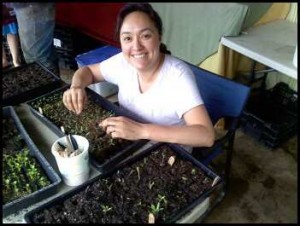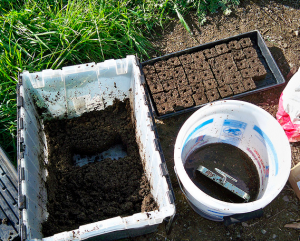A couple of Saturday’s ago I joined the work crew at Howling Wolf Farm. I imagined I’d spend the day doing back-breaking labor, bent over the fields, the sun cruelly beating the sweat out of me while I planted seedlings in freshly plowed earth. This image was quickly shattered.
Having rained steadily the entire week, the fields were way too soggy to plant anything. Matt explained that you need moist, but dry soil that is nicely fluffed up by a plow for good planting. Stepping on a muddy field will only compact the soil and turn it into clay when it dries. Not good for roots.
Also, the seedlings were outgrowing their tiny soil blocks so the task of the day was to make bigger soil blocks and transplant the seedlings into these until conditions were right for planting in the field. We spent the day working in the farm stand and enjoying a light refreshing drizzle of rain as we carried the finished transplants back to the greenhouse.
What’s a soil block, you say?
Soil blocks are blocks of earth gently compressed into pot shapes for starting seeds. It’s the pot of soil without the pot. According to Carol, ” Soil blocking is a new technique Matt is using this year — it virtually eliminates transplant shock so our food plants won’t have any delays when they are first set out in the fields.” An added benefit is that it cuts down on waste b/c there are no single-use disposable plastic containers involved. Matt has a special soil recipe mix he likes to use which consists of compost, perlite and peat.
Carol describes the process this way: “First you mix up a planting soil for seedlings in the wheelbarrow, then you moisten some of it just right in a shallow tub. Using a long-handled soil block tool, you compact the moist soil into the cubical compartments, and then gently release the soil blocks from the tool into a seed flat. Here’s a picture of the tool we were using. It’s just the right height to lean your weight onto while standing.
Randy and Carol brought food and drink. We ate delicious homemade whole grain bread with homemade butter that was a vivid yellow orange color from all the beta-carotene the cows were getting from the green grass. There was also sausage made with the farm’s pork. I’m kicking myself for not taking pictures, I was so eager to dig in the dirt, I completely forgot to.
If you are interested in volunteering opportunities on organic farms visit the WWOOFing (World Wide Opportunities on Organic Farms) website.
For more info on soil blocks visit betterhensandgardens.



Betty
June 28, 2012
I never knew this. I’ll be taping into all your knowledge of planting vegetables when I move to the suburbs!